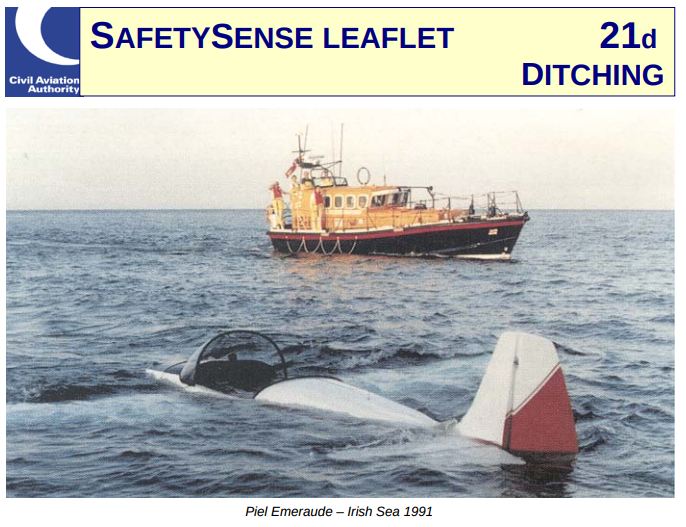I don’t know about a Jodel, but a Piel Emeraude can float long enough to still be on the surface when the RNLI’s Mersey-class all weather lifeboat shows up.

dublinpilot wrote:
It was the most benign circumstances you could ask for. Yet about 75% of the participants failed to get into the raft despite being allowed to take as long as they needed.
172driver wrote:
I’ve said it before, but I’ll say it again: a raft without a ladder is totally useless for anyone other than 20-year old Navy SEALs or similarly athletic people.
Most people cannot even lift themselves out of a swimming pool onto the side – they simply lack the upper body strength. A raft is that much harder because it moves when you press against it. Then you also need the composure and presence of mind not to waste your energy doing counter-productive things.
I don’t think you need to be special forces or an athlete, but you do need sufficient upper body strength to lift your own weight fairly easily. That means that if you weigh a lot, an awful lot of strength is necessary.
Some pull-ups, press-ups and other assorted exercises will make a big difference, more quickly than you might think. But of course most people will dispute that it’s either worth it or possible because, as always, there’s every excuse not to exercise.
Peter wrote:
That’s definitely not correct – see the linked ditching thread.
Good luck, Peter. Without a ladder it’s essentially ballast, nothing more, unless you are… see above.
That’s definitely not correct – see the linked ditching thread.
Maoraigh wrote:
I saw the latter part of an Air Force guy trying to get into a one-man raft, in a choppy sea. Not easy, and when he did get in, it capsized.
I’ve said it before, but I’ll say it again: a raft without a ladder is totally useless for anyone other than 20-year old Navy SEALs or similarly athletic people.
I suspect that is not a true story, unless the Jodel has seals around the rudder pedals, etc. and it was very calm. Or maybe the engine broke off?
A wood and fabric Jodel was reported to be afloat hours after ditching. Baltic??
Wear the lifejacket, otherwise it’s just more weight.
I saw the latter part of an Air Force guy trying to get into a one-man raft, in a choppy sea. Not easy, and when he did get in, it capsized.
Eventually he stayed in, and was rescued.
As he was winched up, they were lowered again. The rescue guy dropped off, swam to the raft, got in easily, and the helicopter departed, leaving him to drift ashore. It’s a skill. All seen from my garden.
There is a wealth of opinions and significant knowledge in the referred threads.
This one about recent events is significant because the airframe broke up significantly (in the TB20). Despite this occupant(s) were apparently uninjured.The Bonanza remained intact and afloat for way more than the standard one minute, and even with zero pitch, vs the standard nose-down. This contrasts. Occupant also uninjured.
Both in (relatively) coastal waters so rescue was nearby and survival equipment not a factor (this is not generally the case)
Also in both cases, the pictures show entry door(s) closed post ditching.
IO390 wrote:
Personally I think I will stick to life jacket + raft for open water crossings from now on.
I would advise you to take a ditching course in a pool, if you ever have the opportunity. It’s eye opening.
I had a change to do one years ago. It wasn’t very realistic, in that there was no dunker (so no submerged/escape to be done) and was in a warm swimming pool, so no freezing shivering mussels.
It was the most benign circumstances you could ask for. Yet about 75% of the participants failed to get into the raft despite being allowed to take as long as they needed.
It’s surprising how high a raft walls are when just your head is sticking out of the water!
For me the big takeaway was:
1. Try not to get wet. If you can get into the raft when the aircraft is still floating so you can step from the aircraft into the raft. If you’re lucky enough for this to be possible it makes things a lot easier.
2. If you can avoid it, don’t inflate your life jacket until inside the raft. the extra distance that the jacket keeps you from the raft makes it much harder to get it.
3. Know your life raft and what aids it has to help you get in. If you are in the water, you’ll need an aid to get it. Some have steps, some of ropes to pull on and some have ropes that you need to reach in for and pull yourself against. If you don’t know what aids your raft has, you won’t find them when in the water and you won’t get from the water to life raft without either an aid or someone else already in there to pull you in.
There was also some bits on how to turn up a raft that has inflated upside down. Very useful to know.
As I say, I found the course eye opening despite the benign conditions. A raft by itself, and without the knowledge of how to use it, isn’t of much use.